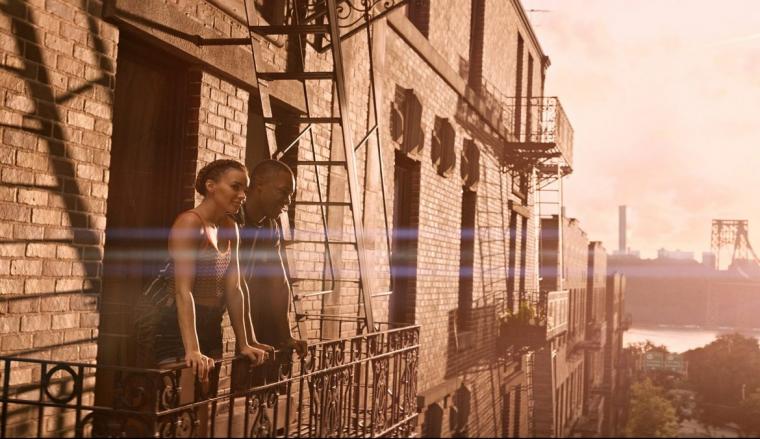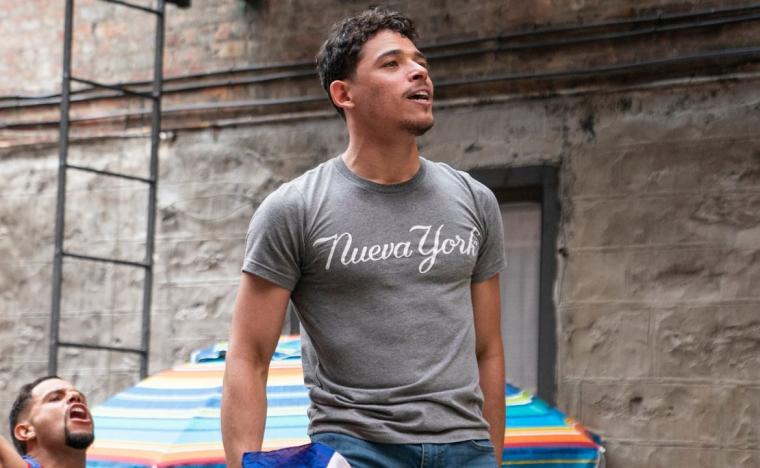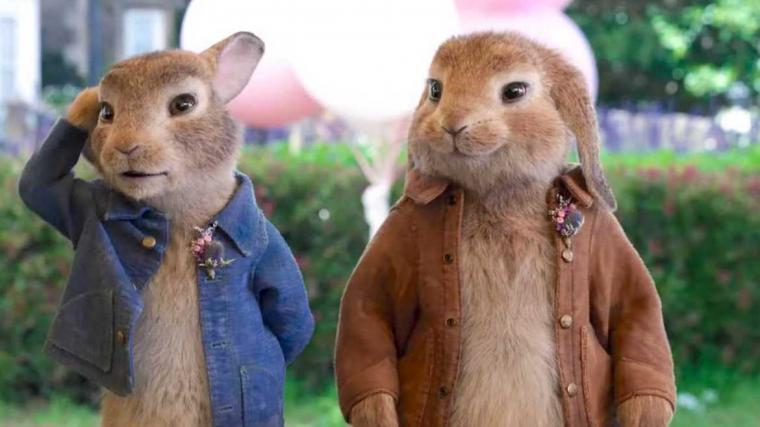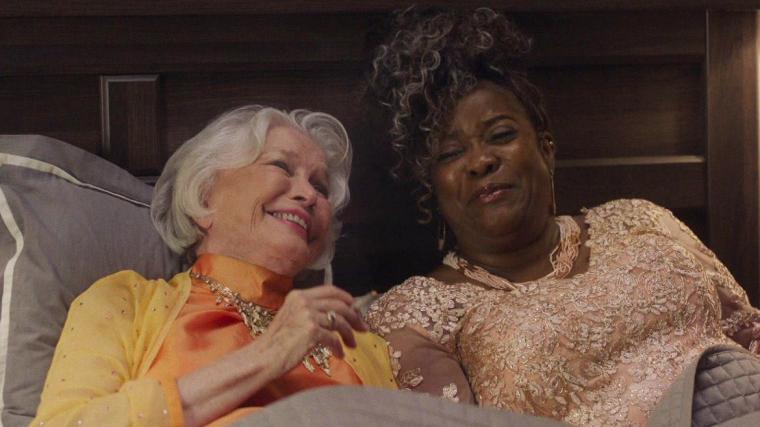
Leslie Grace and Corey Hawkins in In the Heights
IN THE HEIGHTS
Had the musical been released last June as originally scheduled, and had there been no pandemic, director Jon M. Chu's film version of In the Heights would no doubt have felt like what it feels like today: a sweet, touching, frequently thrilling bash in which the guest list simply reads “Everybody.” Arriving now, however – and for we Illinoisans, debuting on the very same day the state's COVID-19 restrictions were lifted – Chu's big-screen opus feels like more than a party; it feels like liberation.
A Tony-winning triumph for composer Lin-Manuel Miranda seven years before the Broadway premiere of Hamilton, In the Heights – which plants a good half-dozen narratives across a few blocks in the Washington Heights borough of Manhattan – has its moments of heartbreak and anger, misery and panic. More than anything, though, the show's infectiously hopeful spirit is soaring and transcendent, and Chu's take on the material is exactly the sort of joyful, magical movie explosion that so many of us have been craving, and have been sadly deprived of, for way too long. I'd recommend seeing it on the biggest screen possible … despite the fact that, because of a busier-than-usual weekend, I myself watched it via the convenience of HBO Max. (I know, I know. I'm part of the problem.)
Like most metropolitan neighborhoods, the New York City barrio envisioned by Miranda and original book writer/screenwriter Quiara Alegria Hudes is crowded, and running a speedy, ideally paced 140 minutes, Chu's In the Heights is, too. Our chief protagonist and occasional narrator – the man who opens this down-to-earth fairy tale with “Once upon a time, in a place called Nueva York …” – is Usnavi de la Vega (the endearing, soulful Anthony Ramos), a struggling bodega owner who, as he approaches his thirtieth birthday, longs for the beauty and comparative freedom of his Dominican Republic homeland. He's currently making plans for his dream to come true – and he's hardly the borough's only dreamer, or capitalized Dreamer.
Usnavi's undocumented teen cousin and employee Sonny (Gregory Diaz IV) wants desperately to be an American citizen, especially living in a political climate heavily fixated on deportation. Salon worker Vanessa (Melissa Barrera), for whom Usnavi carries an ill-hidden torch, yearns for an upscale apartment and a career as a fashion designer. Salon owner Daniela (Daphne Rubin-Vega) is preparing for a business expansion in the Bronx. Cab-service owner Kevin (Jimmy Smits), who never finished high school, works tirelessly yet proudly to pay for his daughter's continued enrollment at Stanford University. That daughter, Nina (Leslie Grace), aches to return to the Heights without crushing her father's wishes for her higher education. Kevin's dispatcher Benny (Corey Hawkins) pines for a life with Nina, having ended their relationship when she left for California. Even the fringe figure of the local shaved-ice vendor (Mr. Miranda himself) has a dream – though his is more accurately a forlorn hope that the neighborhood's Mr. Softee truck would just go the hell away.

Without even mentioning Vanessa's gossipy salon co-workers (Stephanie Beatriz and Dascha Polanco), the barrio's resident graffiti artist (Noah Catala), and the Heights' collective, beloved abuela Claudia (Olga Merediz, reprising her Tony-nominated Broadway role), that's a lot of characters to keep straight and keep track of, especially considering most of them are quickly introduced over the seven minutes of the opening hip-hop-pop number. (Unfortunately, this is one of the film's few tracks in which the sound mixing isn't top-tier; while the accompanying visuals are sensational, it's tough to decipher the lyrics when more than two individuals sing at once.) Yet much the way Moulin Rouge! needs its initial hyperactivity to acclimate you to the deliberately fantastical flights of fancy ahead, In the Heights' title song and eye-popping images – So many people! So much exuberant choreography! Such arresting colors! – start the proceedings with an oversize bang so we can better enjoy the subtler fireworks that follow. Its “book scenes” may be played as realistic, but like 2019's Elton John bio-pic Rocketman, Chu's musical doesn't make the mistake of striving for naturalism in any of its musical numbers. Given their staggering success rate, naturalism would have just impeded the fun.
Thinking back on the In the Heights experience, your head can start swimming with memories of Chu's theatrically cinematic (cinematically theatrical?) flourishes. The wigs and weaves in Daniela's beauty shop bopping along to the playful “No Me Diga.” Usnavi and his boys, at the start of “96,000,” drawing animated pictures as they strut toward the neighborhood pool. Nina and Benny defying gravity in their “When the Sun Goes Down” duet. Life and death and the afterlife colliding in Claudia's heart-wrenching “Paciencia y Fe” solo. Yet you may just as easily be thinking about the more recognizably human-scaled bits: Benny showing off his professional acumen and visible love for his job in “Benny's Dispatch.” Nina, in “Breathe,” sadly and pointedly referring to herself as “the biggest disappointment you know.” Usnavi nervously futzing with the cork during “Champagne.” Like the sea of brown, black, and random white faces in large group scenes, In the Heights blends its ultra-imaginative and intimate pleasures so they become beautifully inseparable. It's a film of harmonies, and it is harmony.
And even given the more downbeat sequences that are uniformly moving, lord almighty is this thing a banquet of exhilarating highs; over the course of two hours and 20 minutes, just about the only things the movie doesn't find room for are weak songs and weak performances. [I won't even pretend to have a favorite among Chu's ridiculously magnetic cast, though I will say that (a) Corey Hawkins is almost obscenely charismatic; (b) Daphne Rubin-Vega should be officially deemed a national treasure; and (c) Jimmy Smits can actually carry a tune!] Usnavi spins a manhole cover on his finger. A rousing musical number ends a days-long, city-wide blackout. Kevin is put on hold and forced to listen to a Muzak version of “You'll Be Back” from Hamilton. Chu's remarkable entertainment is rousing and inspiring and intoxicating … and is landing at such a perfect time that you never even think to flinch at everything 16 months of a pandemic should have caused us to flinch at. Dozens gather in a public pool and sweaty bodies mingle in a nightclub and characters actually pick up their food in person as opposed to having meals delivered, and it all feels as natural, and gloriously unnatural, as can be. We may not be altogether “back to normal,” but having cineplex options such as In the Heights feels like a step – make that a tremendous, blessed leap – in the right direction.

PETER RABBIT 2: THE RUNAWAY
During the course of Peter Rabbit 2: The Runaway, references are made to the title character's voice, with one character labeling it “annoying” and another opting for the slightly less critical “polarizing.” That Peter Rabbit is again voiced by James Corden makes this running gag extra-amusing.
Personally, I've never had a problem with the British performer's vocal timbre. It's Corden himself who can be irritating beyond belief. (I don't think I've ever witnessed a lazier job of hosting than the man's pathetic cast “interview” in HBO Max's Friends reunion; Corden couldn't even pretend he was hired for anything beyond pitching softballs.) Yet despite his readings and wisecracks not being nearly as fresh as they were in the 2018 original, Corden is still entertaining in director Will Gluck's followup, and happily, just about everything else is, too. Although it takes a while to get rolling and its finale is kind of lame, The Runaway is another blast of verbal and visual slapstick likely to delight kids and infuriate Beatrix Potter purists, and the film is certainly one of the more enjoyably meta sequels I've yet seen. Picture 22 Jump Street with Tatum and Hill replaced by CGI barnyard critters and you'll get the general idea.
Gluck's and co-screenwriter Patrick Burleigh's central narrative, which I'm presuming is at least loosely inspired by Potter, finds our mischievous bunny leaving country life for the big city and joining a group of urban rapscallions in pilfering food and causing mayhem and, in general, acting like the Peter Rabbit of the first film. That stuff is fun. But the truly inventive fun comes with the extended subplot that finds the now-married Thomas McGregor (Domhnall Gleeson, riotously fearless) and Bea (Rose Byrne, slyly sardonic) considering the licensing of her Peter Rabbit book to a literary behemoth headed by Nigel Basil-Jones (David Oyelowo), a suavely untrustworthy smoothie with plans for sequels that outfit Peter and pals in high tops and send them into space.
The film's computer animation is stellar and the animals voiced by Corden, Margot Robbie, Elizabeth Debicki, Aimee Horne (replacing the original's Daisy Ridley), and others are terrific. For my money, though, I would've been totally happy with an entire movie devoted to the countrified McGregors and their mini-adventures on the road to selling out: Thomas getting woozy at the romantic flirtation of Nigel's eyes; Bea worrying that her delicate works might eventually be turned into crass film scripts “probably adapted by some Americans.” (That line gets a deserved breaking of the fourth wall.) So while the young-'uns can cackle at Thomas' flailing tumble down a hill and the rooster's continued existential crisis and the deer now being hypnotized by a “fla-a-a-ashlight” – all bits that made me cackle, too – there's plenty for adults in Peter Rabbit 2: The Runaway, as well. In truth, my biggest gripe with the movie is more of a niggling concern, given that I've never known whether the correct term is “farmer's market” with an apostrophe or “farmers market” without one, and Gluck's sequel has the nerve to spell the phrase on-screen both ways. Now I might never get closure.

QUEEN BEES
Directed by Michael Lembeck, an Emmy-winning TV veteran responsible for some of the funniest episodes of Friends (plus, regrettably, two of Tim Allen's three Santa Clause movies), the sentimental comedy Queen Bees sends an independent, octogenarian widow into a month-long stay at a posh retirement community where she gradually befriends the resident “mean girls,” begins a tentative romance with a charming widower, and slowly reconciles with her estranged daughter. Shot in an overly bright visual style reminiscent of synthetic sitcoms from the 1980s, Lembeck's outing is relentlessly, almost oppressively chipper even when addressing subjects such as cancer, dementia, and debilitating loneliness, and in lesser hands, it could have been unbearable. (Hell, it could've been unbearable even in gifted hands, like those of Diane Keaton.) Instead, barring a few lapses in motivation and taste, it's a real winner, and even though it's rather bland, the movie is also made close to moving thanks to the exceptional acting talent involved.
At 91, Clint Eastwood is still playing leading roles on-screen – he's got another scheduled for October – but has any Hollywood feature prior to this one boasted an 88-year-old female as its star? Queen Bees is an outstanding argument for more of them, at least if that 88-year-old is Ellen Burstyn, who's so effortless, quick-witted, and beautiful here that while I never outright laughed during the film, it was barely possible not to sport a feature-length smile. Even when her Helen Wilson is frustrated or frightened or hurt, Burstyn exudes utter radiance, and still manages to make the art of acting look as ticklish as she did a full half-century ago in The Last Picture Show (and by then, the performer had already been a frequent television presence for 13 years). I admired Burstyn's brief, pungent turn in the recent Pieces of a Woman, where it was clear that she'd lost none of her snap and drive. But I simply adored her in Queen Bees, which gives the legend her most expansive role in decades, as well as one of the few to showcase her devastating comic timing. (Asked if her mother is on any medications, Helen's daughter, played with an admirable lack of schmaltz by Lost's Elizabeth Mitchell, answers the query with, “Only for her dry wit.”)
Burstyn is so magnificent, in truth, that her unreasonably superb supporting cast could almost be afterthoughts – though they most definitely aren't. As the 80-something widower who catches Helen's eye, James Caan is a sweeter, more relaxed figure than he's been in ages; his exchanges with Burstyn truly seem to be taking place in those moments for the first time, and when the two share a dance, your mind grows so filled with memories of their long screen histories that you can get misty-eyed without feeling at all manipulated. (Is this the first time Burstyn and Caan have been paired together? If so, how is that possible?) Ann-Margret starts out as a lascivious-old-broad stereotype before reminding us that, when casting directors choose to remember it, she's also an awfully fine dramatic actor. The gloriously irrepressible Loretta Devine lends the film her signature exuberance, and is a real kick in the five-minute, single-take sequence in which she and Burstyn smoke weed. Christopher Lloyd, whose toupee is the sight gag that keeps on giving, lifts your spirits before breaking your heart. Dandy minor turns are provided by Alec Mappa, Ricky Russert, and the too-rarely-seen French Stewart. And Jane Curtin, playing the sourest resident in sight, is almost nastier than she needs to be – and good for her. It's a perfect portrayal despite the imperfect writing, as this ice queen isn't going to melt for you or anyone else … though she might just thaw a bit. There are dumb jokes and contrived plot turns aplenty and I still had a wonderful time at Queen Bees, a celebration of the golden years that – and I'm so sorry for this – is positively Burstyn with life.










